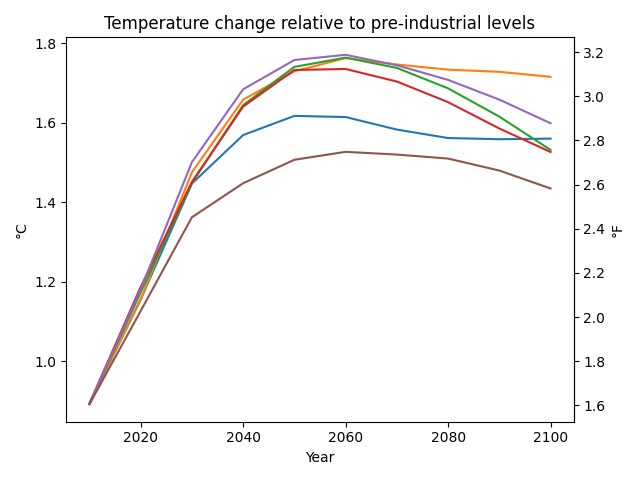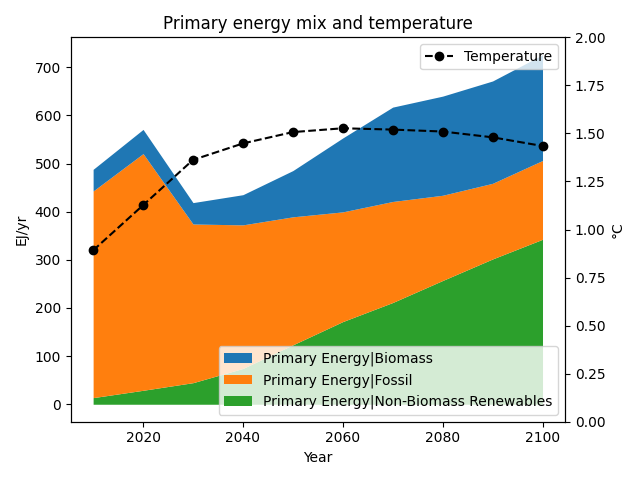Note
Go to the end to download the full example code
Composing plots with a secondary axis¶
# sphinx_gallery_thumbnail_number = 2
Read in tutorial data and show a summary¶
This gallery uses the scenario data from the first-steps tutorial.
If you haven’t cloned the pyam GitHub repository to your machine, you can download the file from https://github.com/IAMconsortium/pyam/tree/main/docs/tutorials.
Make sure to place the data file in the same folder as this script/notebook.
import matplotlib.pyplot as plt
import pyam
df = pyam.IamDataFrame("tutorial_data.csv")
df
/home/docs/checkouts/readthedocs.org/user_builds/pyam-iamc/checkouts/stable/pyam/utils.py:318: FutureWarning:
The previous implementation of stack is deprecated and will be removed in a future version of pandas. See the What's New notes for pandas 2.1.0 for details. Specify future_stack=True to adopt the new implementation and silence this warning.
<class 'pyam.core.IamDataFrame'>
Index:
* model : AIM/CGE 2.1, GENeSYS-MOD 1.0, ... WITCH-GLOBIOM 4.4 (8)
* scenario : 1.0, CD-LINKS_INDCi, CD-LINKS_NPi, ... Faster Transition Scenario (8)
Timeseries data coordinates:
region : R5ASIA, R5LAM, R5MAF, R5OECD90+EU, R5REF, R5ROWO, World (7)
variable : ... (6)
unit : EJ/yr, Mt CO2/yr, °C (3)
year : 2010, 2020, 2030, 2040, 2050, 2060, 2070, 2080, ... 2100 (10)
Create a figure with different units on secondary axis¶
To create a chart with multiple axes, we directly use the matplotlib package
and start with a subplot consisting of a figure canvas and
an Axes object, which contains the figure elements.
First, we generate a simple line chart with temperature increase in °C
for one scenario and multiple models.
We now tell pyam to specifically use the ax instance for the plot.
Then, we create a second axis ax2 using
Axes.secondary_yaxis()
showing temperature increase in °C from the original axis ax
to temperature increase in °F.
fig, ax = plt.subplots()
args = dict(
scenario="CD-LINKS_NPi2020_1000",
region="World",
)
temperature = "AR5 climate diagnostics|Temperature|Global Mean|MAGICC6|MED"
title = "Temperature change relative to pre-industrial levels"
data_temperature = df.filter(**args, variable=temperature)
data_temperature.plot(ax=ax, title=title, legend=False)
ax2 = ax.secondary_yaxis("right", functions=(lambda x: x * 1.8, lambda x: x / 1.8))
ax2.set_ylabel("°F")
plt.tight_layout()
plt.show()

Create a composed figure from several plot types¶
To create a composed chart, we again use the matplotlib package
and start with a subplot consisting of a figure canvas and
an Axes object, which contains the figure elements.
First, we generate a simple stacked chart
of all components of the primary energy supply for one scenario.
We now tell pyam to specifically use the ax instance for the plot.
Then, we create a second axes using Axes.twinx()
and place a second plot on this other axes.
fig, ax = plt.subplots()
args = dict(
model="WITCH-GLOBIOM 4.4",
scenario="CD-LINKS_NPi2020_1000",
region="World",
)
data_energy = df.filter(**args, variable="Primary Energy|*")
data_energy.plot.stack(ax=ax, title=None, legend=False)
temperature = "AR5 climate diagnostics|Temperature|Global Mean|MAGICC6|MED"
data_temperature = df.filter(**args, variable=temperature)
ax2 = ax.twinx()
format_args = dict(color="black", linestyle="--", marker="o", label="Temperature")
data_temperature.plot(ax=ax2, legend=False, title=None, **format_args)
ax.legend(loc=4)
ax2.legend(loc=1)
ax2.set_ylim(0, 2)
ax.set_title("Primary energy mix and temperature")
plt.tight_layout()
plt.show()

/home/docs/checkouts/readthedocs.org/user_builds/pyam-iamc/checkouts/stable/pyam/plotting.py:466: FutureWarning:
The behavior of array concatenation with empty entries is deprecated. In a future version, this will no longer exclude empty items when determining the result dtype. To retain the old behavior, exclude the empty entries before the concat operation.
Total running time of the script: (0 minutes 0.761 seconds)